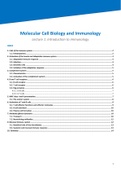Class notes
Lecture 1. Basis of immunology (AM_470656)
- Course
- Institution
- Book
Contains information and images on cells of the immune system, activation, initiation of the immune response, B and T cells, the complement system, MHC receptors, antibody functions, and information on the mucosal immune system (including microbiome).
[Show more]




